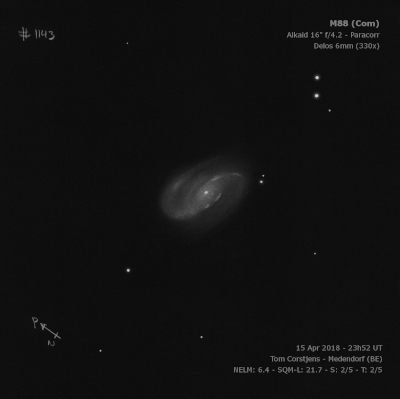
Charles Messier discovered M88 = NGC 4501 = h1312 on 18 Mar 1781. William Herschel described it on 14 Jan 1787 (sweep 691) as "vB, vL, E." JH made 5 observations and recorded on sweep 422 "B; vL; vmE; 8' l, 1' br. The northern half is brighter than the southern." On two other sweeps heaccurately measured the position angle as between 140°-145°. Listed as "Spiral or curvilinear" in Lord Rosse's 1850 PT paper.
At Birr Castle, R.J. Mitchell recorded on 9 Mar 1855 "Another spiral? dark spaces p[receding] Nucl, others also, especially one sf [south-following] Nucl. Six nights later he logged "Thought I could trace a dark passage from south end down past the Nucl. Saw but the one branch f neby outside this passage." William Lassell sketched M88 on 21 May 1862 using his 48-inch on Malta. He noted "this nebula is of a somewhat convoluted form it may be a spiral, but I cannot make it out." Nevertheless, a comparison of his sketch with images, shows the tight set of spiral arms around the core and another spiral arm curling around on the southeast side of the halo.
400/500mm - 17.5" (4/25/87): very bright, very large, elongated 5:2 NW-SE, brighter core, intense very small or stellar nucleus (Seyfert 2 galaxy). A faint double star is embedded at the SE end (mag 13.5/14.5 at 20"). A brighter double star mag 11/12 at 30" is 5' S of center. Located at the NE end of "Markarian's chain" in the core of Virgo cluster.
900/1200mm - 48" (4/5/13): a thin spiral arm was clearly visible extending along the entire western flank of the halo and stretching 4.5' from NW to SE. This arm separates more cleanly from the central region as it extends south, reaching a wide double star (13.7/14.3 that is superimposed on the southeast end. A fainter, very thin, straight arm was also visible along the east side of the galaxy, extending towards the northwest. This arm hugs pretty close to the east side of the core and separates a bit on the north side.
Notes by Steve Gottlieb